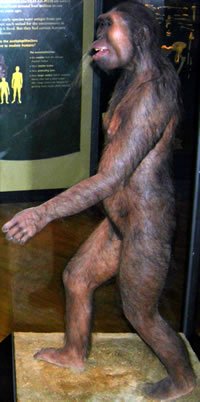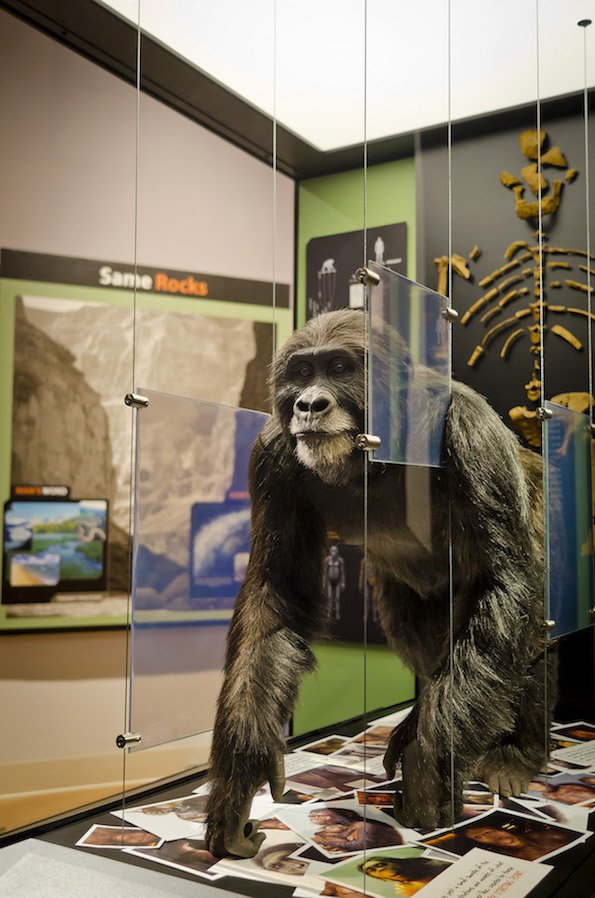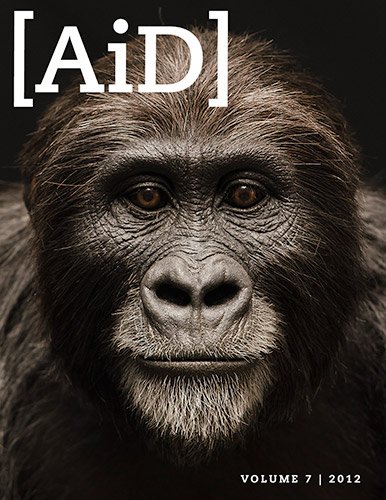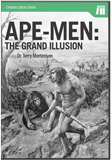
A Look at Lucy’s Legacy
Abstract
Perhaps more than any other fossil, Lucy is presented as “exhibit A” for evolutionists in their attempt to show that humans evolved from an ape-like ancestor. With the recent opening of the Lucy exhibit in the Creation Museum, Answers in Genesis felt it was appropriate to present the “Lucy story” to our web visitors as well. This article will explore the origins of the fossils and interpretations by evolutionists that have led to overtly human-like representations of Lucy, such as at the Field Museum in Chicago, that differ so greatly from the equally valid representation at the Creation museum.
41st Anniversary of the Discovery of Lucy

As Google reminded us, November 24, 2015, marked the 41st anniversary of the discovery in Ethiopia of the australopithecine popularly known as Lucy. The “Google Doodle” from November 24 honored the supposed human ancestor, and the drawing illustrates the worldview that believes in a supposed gradual evolution from ape to modern man, with Lucy in-between. According to evolutionists, Lucy walked on two legs, and the group she represents is a distinct ancestor of humanity (though how closely related is disputed in their camp.) But Lucy wasn't a human ancestor. She's an extinct variety of ape. Google isn't promoting science—they are promoting an interpretation of the past that is a key idea in the atheistic religion of naturalism. Read more.
Introduction
Is she, or isn’t she? Lucy has long been hailed (by evolutionists) as the poster-child for bipedality over braininess—the proof that our ancestors learned to walk on two legs before they really learned to think on their feet. Is Lucy, the now legendary Australopithecus afarensis fossil found in 1974, the real mother of humanity? Is that even the question?
Opinions among evolutionists vary—Was Lucy the oldest pioneer of bipedality? Did she have an arched foot or not? Did her cousins walk boldly upright across Tanzania leaving footprints at Laetoli? Was she a closet knuckle-walker who kept her options open? Was her branch on the evolutionary tree the one that led to us or just a dead end? Have new findings concerning the shape of her jaw (a more gorilla-like morphology1 than a human ancestor should have!) lost her spot on the trunk of our hominid tree? Have the numerous re-datings of Lucy and other discoveries such as Homo habilis finally arrived at an acceptable set of dates? Or are these even the right questions to be asking? What, truly, is Lucy’s legacy?

A life-size model of “Lucy” at The Field Museum in Chicago. Photo courtesy of Mark Looy.
Lucy Goes Public
A few years ago the government of Ethiopia—ancient home to Lucy’s mortal remains for 3.2 million years2 (by currently accepted evolutionary reckoning) except for a brief sojourn in Cleveland3—agreed to send Lucy on a tour of the United States. A controversy ensued as a number of high-profile evolutionary paleontologists objected, largely due to the fear of damage to humanity’s irreplaceable anthropological heritage. Some felt the scheme would only make money for the Ethiopian government and objected to exploiting Lucy for such purposes. The Smithsonian Institution’s Natural History Museum in Washington, D.C., and The Field Museum in Chicago even refused to host the exhibit.4
Lucy’s discoverer, Donald Johanson, approved of the tour in hopes of raising public interest in the study of human origins. Despite a premature end to the tour after the turnout in Seattle proved disappointing, Lucy remains a well-recognized name. An amazing variety of representations reflecting a good deal more artistic creativity than forensic fidelity in museums and zoos around the world has seen to that. Only time will tell whether paleoanthropologist Lee Berger is able to achieve similar success with his “Karabo,” (a.k.a. South Africa’s Australopithecus sediba), the latest addition to the hominid hall of fame.5 So what is it about this collection of bones that has so captured public imagination?
Lucy was discovered in the Hadar area of Ethiopia’s Afar Depression, the northernmost part of the Great Rift Valley, in 1974. A year earlier, at a site 1 ½ miles (2 ½ kilometers) away and 230 feet (70 meters) deeper in the geologic strata, Donald Johanson had found pieces of a tibia (shinbone) and femur (thighbone) and judged them to meet at an angle consistent with the knee of a bipedal creature. Although Lucy’s 47 discovered bones do not include a knee joint, Johanson believes they are from the same species as the 1973 “knee.” And despite criticism from other evolutionary paleontologists asserting “that it was nothing more than a monkey knee,” as Johanson writes in Lucy’s Legacy, “I never veered from my original assertion that the knee belonged to a biped.”6
Lucy and the History of Bipedality
Popular publicity surrounding Lucy has built a legacy that will outlast her periodically shaky position on the hominid evolutionary tree.
So what is the big deal about being bipedal? “Bipedalism has traditionally been regarded as the fundamental adaptation that sets hominids apart from other primates,”7 as evolutionary anthropologists Brian Richmond and David Scott have written in the journal Nature. Evolutionists have long debated whether hominids stopped swinging through trees and learned to walk upright before they exercised their brains enough to evolve one worth calling Homo or whether bigger better brains evolved first. More importantly, evolutionists need to accumulate a chronological series of fossils each displaying progressively more human-like features and make sure the dates on those fossils show an evolutionary sequence preceding the appearance of Homo sapiens on the past earthly landscape. If they can produce such a series, then as Richard Leakey has said, “even the skeptics can accept it.”8 As such, popular publicity surrounding Lucy has built a legacy that will outlast her periodically shaky position on the hominid evolutionary tree.
Footprints for Lucy
Johanson bolstered his claims after Mary Leakey’s 1976 discovery of the Laetoli footprints in Tanzania, roughly 1000 miles9 away from the site of Lucy’s 1974 discovery in Ethiopia. Leakey unearthed a trail of fossilized footprints belonging to several bipeds (two, three, or four—possibly including a juvenile stepping in the bigger prints—depending on whose analysis you accept).10 The prints look like those of habitually barefoot people, and their morphology and evident gait demonstrate that whoever made them walked upright on two legs.
Paleoanthropologist Timothy White, who has worked with both Leakey and Johanson, attests to the obviously human appearance of the Laetoli prints. “Make no mistake about it, they are like modern human footprints,” he explains. “There is a well shaped modern heel with a strong arch and good ball of the foot in front of it. The big toe is straight in line. It doesn't stick out to the side like an ape toe.”11 White, who—unlike Mary Leakey—did associate the Laetoli prints with Lucy, also commented on the human-like gait the prints depict. He said, “I don’t mean to say that there may not have been some slight differences in the foot bones; that’s to be expected. But to all intents and purposes, those Laetoli hominids walked like you and me, and not in a shuffling run, as so many people have claimed for so long.”12
Yet because radiometric dating of the volcanic tuffs in which the footprints were made points to a 3.66 million year date for them,13 evolutionists maintain these prints cannot be human, no matter what they look like (because humans had not yet evolved). There are some fragmentary Australopithecus afarensis fossils in the tuff beds around Laetoli.14 Nevertheless, Leakey disagreed when Johanson identified the makers of the Laetoli tracks as Australopithecus afarensis, saying Johanson’s work was “not very scientific.”15 Despite her objections,16 Johanson announced, at the May 1978 Nobel Symposium held in Sweden to address the “Current Argument on Early Man,” that the Laetoli footprints were made by Australopithecus afarensis, the same species as Lucy.17
More Controversy
Over the years, various objections to Lucy’s bipedality have emerged among evolutionists. For example, anthropologist Russell Tuttle from the University of Chicago, as reported in Science News, believes that the Laetoli prints were made by a contemporary but much more human-like creature than Lucy.18 More recently, experts have decided that Lucy walked on flat feet but that others of her species had arched feet.19

This Lucy exhibit is located in the Creation Museum’s “Starting Points” room.
Stern and Susman in 198320 as well as Tuttle21 believed that Lucy’s pelvis was well-adapted for arboreal (tree-dwelling) life. They, like many others, noted that the orientation of the iliac blade on the pelvic bone matched that of chimpanzees, not humans. (The iliac blade is a wing-shaped part of the pelvis, or hip bone.)
The first bit of evidence that convinced Johanson he had found a Hadar hominid back in 1973, the valgus (slightly knock-kneed) angle of the knee, is actually present in some apes, notably the orangutan and the spider monkey. Therefore, the angle of the knee is not diagnostic of bipedality, despite Johanson’s confidence that he had found a new hominid. But the diagnosis of bipedality rests on more evidence, including the australopithecine pelvis and the suggestion of a lumbar curve in some reconstructions.
The orientation of the iliac blades on the pelvis is a key skeletal requirement for bipedality. The orientation of the iliac wings on the human pelvis allows the human to use gluteal muscles to counterbalance the lifting of the opposite leg during bipedal walking. This stabilizes our hips and keeps us from falling over sideways with each step. The differing orientation of ape iliac bones prevents this use of the gluteal muscles and forces apes to shift and sway from side to side when they occasionally walk upright, rendering an efficient bipedal gait skeletally impossible.
Owen Lovejoy, who worked with Johanson analyzing the Lucy fossils and the casts made from them, believed the first reconstruction of Lucy’s pelvis to be in error and, in a much-publicized video shown on public television,22 demonstrated how casts of the bone fragments could be rearranged to produce a more human-like pelvis suitable for bipedal locomotion. Lovejoy believes his pelvic reconstruction demonstrates the pelvic muscles stabilized Lucy’s pelvis as they do in humans, giving her a gait like a human, “fully bipedal and adapted to life on the forest floor.”23
Other analyses taking advantage of modern technology, such as those by Christine Berge published in 199424 and 201025 in the Journal of Human Evolution, offer a different reconstruction allowing for a unique sort of locomotion. Berge writes, “The results clearly indicate that australopithecine bipedalism differs from that of humans. (1) The extended lower limb of australopithecines would have lacked stabilization during walking; and (2) the lower limb would have shown greater freedom for motion, which can be interpreted as the retention of a partly arboreal behavior.”26
What Berge calls “australopithecine bipedalism” is not at all the bipedalism associated with humans. Her reconstruction of Lucy’s pelvis demands the gluteal muscles be arranged like an ape’s. This arrangement, while enabling an australopithecine to move its legs in unique ways, would still be too unstable for truly bipedal locomotion. Furthermore, Berge maintains the pelvic anatomy was still adapted for arboreal life. Berge believes evolving australopithecines retained ape-like anatomy while acquiring bipedality. Does this support the evolutionists’ original contention? Did a series of missing links make gradually more upright alterations in their gait until they were able to free their hands to use tools and concentrate on evolving bigger brains?
Handy Anatomy
The bipedal question, of course, is not whether proposed hominid ancestors were able to walk upright—any chimp today can do that after a fashion for brief periods—but whether bipedal locomotion was the normal and efficient way of getting around. From the evolutionary point of view, evolving hominids needed to free their hands for other uses. A hominid that spent a good deal of time knuckle-walking would therefore fail as a convincing candidate for human ancestor. Oddly enough, though, some of the most convincing evidence against Lucy’s proposed bipedalism comes not from her lower extremities but from her wrists. Evolutionists Brian Richmond and David Strait compared the skeletal morphology of living knuckle-walking primates to the bones of Australopithecus afarensis. Lucy’s bones show the features used to lock the wrist for secure knuckle-walking seen in modern knuckle-walkers.
In addition to wrists designed for knuckle-walking, Richmond and Strait noted that Lucy also had neck, shoulder, arm, finger, and toe anatomy suited to arboreal life. They believed Lucy was adding bipedal abilities to her already efficient “repertoire consisting of terrestrial knuckle-walking, arboreal climbing and occasional suspensory activities, not unlike that observed in chimpanzees today.”27 They question why such a creature would evolve bipedalism. Bipedal locomotion would likely make a forest creature more visible and vulnerable to predators. Thus, even if one were to accept Berge’s implications that a different kind of bipedalism had evolved in Lucy without loss of her arboreal abilities, one would still need to explain how the simple addition of an upright walking posture would be selected as a survival advantage and retained by evolutionary pressures.
Walking in Line—The Evolutionary Worldview
The interpretation of evidence from the fossil record depends on the worldview of the interpreter. These fossil-bearing strata, some at Johanson’s insistence, have been repeatedly subjected to dating methodologies producing a wide variety of dates. If the bony inferences and the dates assigned to various fossils can be made to line up in the desired order, then Lucy and other discoveries (like “Ardi”28 and the recently discovered Burtele foot29) can paint an evolutionary picture of hominid “experimentation” with bipedal variations. Presumably, this experimentation continued until all the tweaked traits became ingrained in the hominid genome leading to you and me. However, not only are these anatomical findings subject to a number of interpretations even on the part of evolutionists, but the fossils simply exist, dated by methods based on a number of unverifiable assumptions and—in the case of Homo habilis30 and Lucy31—redone until “acceptable” results were obtained.32 Nothing about the fossils shows them evolving from anything or to anything. They simply exist as a testimony to some long ago deaths.

The Lucy exhibit in the Creation Museum displays a variety of artistic renderings of what Lucy might have looked like based on fossil evidence.
Johanson defines hominid as “the group of creatures in the human lineage since they diverged from a common ancestor to the African apes,” adding, “Some other scholars employ the word hominin in its place.”33 This definition is based on the assumption that humans evolved from ape-like ancestors. Evolutionists use these words to indicate we evolved. The definition embodies the evolutionary worldview.
Because the evolutionary paradigm assumes transitional hominids existed, evolutionists like Johanson have tried for decades to find human qualities in the fossils of extinct apes. For that reason, an unusual pelvic anatomy must be seen as evidence of bipedalism—even of some variant non-human form. A slightly knock-kneed fossil must be seen as evidence of bipedalism even though similar constructions appear in living apes. Furthermore, due to evolutionary presuppositions demanding the existence of transitional hominids, Lucy’s skeletal features most suited for arboreal life are viewed as evolutionary left-overs “retained” from arboreal ancestors, features on their way to the evolutionary scrap heap.
Many people are absolutely determined to trust millions-of-years dating methods in spite of their basis in unverifiable assumptions.
Much of Lucy’s legacy was built on Johanson’s bold public insistence that Lucy and the Laetoli print-makers were the same species. However, fossils do not walk. The presence of some of Lucy’s cousins in the Laetoli region does not prove those creatures made the prints. Only evolutionary assumptions provide the connection. Evidence discovered by evolutionists like Berge indicates that whatever unique gait Lucy might have been capable of, it was not like a human’s. Additional evidence shows Lucy really was a knuckle-walker. Nevertheless, the powerful image evoked by the Laetoli footprint connection has inextricably linked the footprints and Lucy in the public mind.
Many people are absolutely determined to trust millions-of-years dating methods in spite of their basis in unverifiable assumptions. That commitment combined with a determination that hominid evolution must have happened refuses to admit the Laetoli footprints were made by humans.
The Biblical Worldview
On the other hand, if God created all things and told us what He did in the Bible, then God created each kind of creature—including many that are now extinct—about 6,000 years ago in the same week that He created Adam and Eve. He did so without evolution. Therefore, a now-extinct ape with a unique pelvic anatomical design should not even be considered as a possible missing link. There were none. Anatomical variations do nothing to threaten biblical authority or to support evolution. The point is, God created each to reproduce after its kind.
God created each kind of animal. And He created Adam and Eve. He created them all on the same day, without using evolution. Adopting a biblical worldview means accepting God at His word. It is very easy to get off track and fear the discovery of some variety of ape that could waddle around on two legs might de-rail someone’s faith. However, faith should be grounded in a correct understanding of Scripture and a discernment of the difference between observations of the fossils and interpretations about them. Lucy’s anatomy may suggest a gait that differed somewhat from that of the chimp, but on its best day it was not actually bipedal. In fact, her anatomy is quite consistent with that of a knuckle-walker. But even if Lucy and her cousins had a more versatile anatomy than some other apes, tiptoeing through the jungle didn’t make anything ape-like turn into a person. Nothing could.
Conclusion: Lucy’s Real Legacy
Either God created as He said or man can make up his own story.
Lucy’s legacy is really the same whether evolutionists still consider her to be in the human ancestral line or not. Why? Because Lucy popularized for the public the idea that man evolved from an ape-like ancestor—one with a cute name. We receive angry letters from people deriding us for not realizing everybody knows Lucy walked upright and therefore had to be our ancestor—but that isn’t really the point. New methods of analyzing fossils can refine guesses about their original anatomy and musculature, but those analyses can only improve our guesses about how extinct creatures moved. Those analyses can never demonstrate that ape-like creatures evolved into humans. The point is the source of authority. Either God created as He said or man can make up his own story. In matters of historical (origins) science, a person’s choice of worldview-based starting assumptions determines his conclusion.
Footnotes
- “Mandibular ramus morphology on a recently discovered specimen of Australopithecus afarensis closely matches that of gorillas. . . . The presence of the morphology in both the latter and Au. afarensis and its absence in modern humans cast doubt on the role of Au. afarensis as a modern human ancestor,” according to Rak, Yoel, Avishag Ginzburg, and Eli Geffen. 2007. Gorilla-like anatomy on Australopithecus afarensis mandibles suggests Au. afarensis link to robust australopiths. Proceedings of the National Academy of Sciences 104 no. 16:6568–6572.
- Walter, Robert. 1994. Age of Lucy and the First Family: Single-crystal 40Ar/39Ar dating of the Denen Dora and lower Kada Hadar members of the Hadar Formation, Ethiopia. Geology 22:6–10.
- The original Lucy specimen spent several years in the Cleveland, Ohio, laboratory of her discoverer for anthropologic examination and was then returned for safe-keeping to Ethiopia. There have been about twenty other specimens thought to be Australopithecus afarensis, and “Lucy” can refer to all the specimens collectively or to the specimen whose 47 bones Donald Johanson originally discovered. Since the original “Lucy” achieved great fame, in this article the name refers to that specimen.
- Gibbons, Ann. 2009. Lucy's American Tour Fizzles. Science blog, March 13. http://blogs.sciencemag.org/origins/2009/03/lucys-american-tour-fizzles.html
- Mitchell, Elizabeth, David Menton, and Andrew Snelling. 2011. Sediba with a Little Sleight of Hand. Answers in Depth 6 no. 1.
- Johanson, Donald, and Kate Wong. 2009. Lucy’s Legacy, p. 14. New York: Harmony Books.
- Richmond, Brian, and David Strait. 2000. Evidence that humans evolved from a knuckle-walking ancestor. Nature volume 404:382–5.
- Associated Press. 2012. Evolution skeptics will soon be silenced by science: Richard Leakey. May 28. http://www.cbc.ca/news/technology/story/2012/05/28/f-richard-leakey-evolution.html
- Anonymous. 1979. The Leakey Footprints: An Uncertain Path. Science News 115, no. 13:196–7.
- Mitchell, Elizabeth. 2012. Weird walkers weigh in on supposed hominid evolution. News to Note, May 5. https://answersingenesis.org/human-evolution/hominids/supposed-hominid-evolution/
- Johanson, Donald, and Maitland Edey. 1981. Lucy: The Beginnings of Humankind, pp. 250. New York: Simon and Schuster.
- Johanson, Donald, and Maitland Edey. 1981. Lucy: The Beginnings of Humankind, pp. 250–251. New York: Simon and Schuster.
- Deino, Alan L. 2011. 40Ar/39Ar dating of Laetoli, Tanzania. In Paleontology and Geology of Laetoli: Human Evolution in Context. Volume 1. Geology, Geochronology, Paleoecology and Paleoenvironment, Terry Harrison, ed., pp. 77–97. Dordrecht, The Netherlands: Springer.
- Harrison, Terry. 2011. Hominins from the Upper Laetolil and Upper Ndolanya Beds, Laetoli in Paleontology and Geology of Laetoli: Human Evolution in Context. Volume 2: Fossil Hominins and the Associated Fauna, Terry Harrison, ed., pp. 141–188. Dordrecht, The Netherlands: Springer.
- Anonymous. 1979. The Leakey Footprints: An Uncertain Path. Science News 115, no. 13:196–7.
- Johanson reports, “I had used her material to advance interpretative ideas she did not support.” from Johanson, Donald, and Maitland Edey. 1981. Lucy: The Beginnings of Humankind, p.291. New York: Simon and Schuster.
- Johanson, Donald, and Kate Wong. 2009. Lucy’s Legacy, p. 20. New York: Harmony Books.
- Herbert, W. 1982. Was Lucy a Climber? Dissenting Views of Ancient Bones. Science News 122, no. 8:116.
- DeSilva, Jeremy M., Zachary J. Throckmorton. 2010. Lucy's Flat Feet: The Relationship between the Ankle and Rearfoot Arching in Early Hominins. PLoS ONE 5 no. 12: e14432. http://www.plosone.org/article/info:doi/10.1371/journal.pone.0014432. And Anonymous. A Giant Leap for Lucy. Answers 6, no. 3:14.
- Stern, Jack T., and Randall L. Susman. 1983. The locomotor anatomy of Australopithecus afarensis. American Journal of Physical Anthropology 60:279–317.
- Herbert, W. 1982. Was Lucy a Climber? Dissenting Views of Ancient Bones. Science News 122, no. 8:116.
- Johanson, Donald. Nova, In Search of Human Origins (Part 1). PBS Airdate: June 3, 1997. Transcript at http://www.pbs.org/wgbh/nova/transcripts/2106hum1.html.
- Herbert, W. 1982. Was Lucy a Climber? Dissenting Views of Ancient Bones. Science News 122, no. 8:116.
- Berge, Christine. 1994. How did the australopithecines walk? A biomechanical study of the hip and thigh of Australopithecus afarensis. Journal of Human Evolution 26, no. 4:259–273. http://www.sciencedirect.com/science/article/pii/S0047248484710165
- Berge, Christine, and Dionysis Goularas. 2010. A new reconstruction of Sts 14 pelvis (Australopithecus africanus) from computed tomography and three-dimensional modeling techniques. Journal of Human Evolution 58:262–272.
- Berge, Christine. 1994. How did the australopithecines walk? A biomechanical study of the hip and thigh of Australopithecus afarensis. Journal of Human Evolution 26, no. 4:259–273. http://www.sciencedirect.com/science/article/pii/S0047248484710165
- Richmond, Brian, and David Strait. 2000. Evidence that humans evolved from a knuckle-walking ancestor. Nature 404:382–5.
- Blais, Mark R. 2009. Evaluating the Gait Analysis of Ardi. Answers in Depth 4, no. 1. And Anonymous. 2009. Meet “Ardi” Answers 5, no. 1:12.
- Mitchell, Elizabeth. 2012. Transitional tale told by toes (and metatarsals) is full of sound and fury, signifying nothing. News to Note, April 7. "www.answersingenesis.org/articles/2012/04/07/news-to-note-04072012
- Feibel, Craig S., Francis H. Brown, and Ian Mcdougall. 1989. Stratigraphic Context of Fossil Hominids From the Omo Group Deposits: Northern Turkana Basin, Kenya and Ethiopia. American Journal of Physical Anthropology 78:595–622.
- Walter, Robert. 1994. Age of Lucy and the First Family: Single-crystal 40Ar/39Ar dating of the Denen Dora and lower Kada Hadar members of the Hadar Formation, Ethiopia. Geology 22:6–10.
- Lubenow, Marvin L. 1995. The Pigs Took It All. Creation 17, no. 3:36–38.
- Johanson, Donald, and Kate Wong. 2009. Lucy’s Legacy, p. 5. New York: Harmony Books.
Recommended Resources

Answers in Genesis is an apologetics ministry, dedicated to helping Christians defend their faith and proclaim the good news of Jesus Christ.
- Customer Service 800.778.3390
- © 2024 Answers in Genesis



